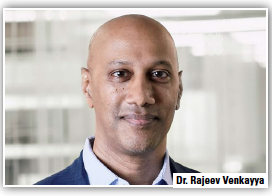Partnering for Public Health
 Rajeev Venkayya, M.D., President of the Global Vaccines Business Unit at Takeda, discusses why the pharmaceutical industry has to be a partner in public-health issues.
Rajeev Venkayya, M.D., President of the Global Vaccines Business Unit at Takeda, discusses why the pharmaceutical industry has to be a partner in public-health issues.
PV: Why is it important for pharmaceutical companies to play a part in public-health discussions, particularly those involving vaccines?
Venkayya: Vaccine development is a complex process; it’s also time-consuming, expensive, and risky. If public-health agencies are going to work on developing vaccines to protect people’s lives in the event of a public-health emergency, they need partners that are highly experienced. Therefore, I believe that it’s essential that companies that have research and development experience and a track record of successfully developing and delivering safe and effective vaccines be part of these discussions.
PV: What can pharmaceutical companies bring to the partnership?
Venkayya: At the end of the development process is a vial or a syringe that contains a vaccine that can save lives or prevent illness, suffering, and death. But to get to that point, it takes an extraordinary amount of effort, and the process involves people who are highly knowledgeable and have experience with vaccine platforms and production processes. When a public-health agency asks a company to work on a vaccine, especially during a health crisis, it is asking a company to shoulder a certain amount of risk. Take Zika for example. A pharmaceutical company undertaking the development of a vaccine for Zika needs to set up a manufacturing infrastructure and redirect its resources from other projects that might have more market certainty, such as a vaccine for respiratory syncytial virus. This is one reason why public-health agencies need to consider de-risking vaccine development for a pharmaceutical company.
PV: What would de-risking vaccine development look like?
Venkayya: The approach varies from company to company because companies have different ways that they weigh risks and different levels of risk tolerance.
But the most common way is to offset the R&D investment that a company needs to make in a vaccine program. Public investments to fund the cost of clinical trials, the manufacturing process, and the salaries of the people working on the program are what I would call push investments that take some of company’s money out of the equation. A company then doesn’t have to worry about whether it should deploy its own capital against the higher-risk program.
Another way to de-risk a program is to provide the developing company a downstream market incentive. If a company were to take on the expense and risk of developing a vaccine, a public-health agency may commit to buy X amount of that vaccine and either stockpile it or sell it in certain markets. That way, the company knows that if it does its job there will be a financial return at the end that helps them to recoup the investment.
PV: How does Takeda approach risk for vaccine programs?
Venkayya: We have two programs that are being supported by external partners. One is our polio program with the Bill & Melinda Gates Foundation; the other is our Zika program with the Biomedical Advanced Research and Development Authority, also known as BARDA, at the U.S. Department of Health and Human Services. In both cases, we receive push funding, meaning the R&D investment is partially or fully offset by external funds.
The Gates Foundation is funding all of our direct expenses, which means the investments that we make. For that program, we’re investing in the salaries of our people, the manufacturing facilities, the know-how in the technology platform, clinical trial expenses, and the cost of producing the vaccine being used in those clinical trials. In the case of BARDA, it is funding a large proportion of our direct and indirect R&D expenses.
Zika is a good example of how we want to operate. Takeda is committed to working on important global public-health problems that are desperate for a solution. This is why we’ve chosen, among many options, to support Zika, dengue, norovirus, and polio. If there is a disease out there that already has a vaccine that is reasonably effective, we don’t think we have a role to play because that need has been addressed. We want to work on important unmet needs.
PV: Why would organizations such as the Bill & Melinda Gates Foundation invest in this research?
Venkayya: Each of these organizations feels a responsibility to deliver a product. They’re investors actually. They have a goal in mind and that mission is to protect human health. As investors, they have gone out and identified companies that they believe can be strong partners to invest in with a goal of getting a product to the people who need it, and ultimately impacting health for many who need a solution.(PV)
~~~~~~~~~~~~~~~~~~~~~~~~~
Takeda’s Vaccine Program
Takeda’s Zika vaccine, TAK-426, is currently being tested in a Phase I trial of 240 patients. In January, the product was given fast-track status by the FDA. TAK-426 is a purified, inactivated whole Zika virus vaccine candidate. In September 2016, BARDA committed $19.8 million to Takeda to cover the development through Phase I and pledged up to $312 million in total.
Beyond Zika, Takeda is pursuing several vaccines, including those for dengue, norovirus, and polio. Takeda’s dengue vaccine candidate, TAK-003, was also granted fast track designation and is currently being evaluated in a pivotal Phase III efficacy study, with initial data expected this year.
In May 2016, Takeda received a $38 million grant from the Bill & Melinda Gates Foundation to support polio eradication. With this funding, Takeda will develop, license, and supply at least 50 million doses per year of Sabin-strain inactivated poliovirus vaccine (sIPV) to more than 70 developing countries. Takeda has several marketed vaccines in Japan where it has been producing vaccines to prevent infectious diseases in adults and children for more than 70 years.


















